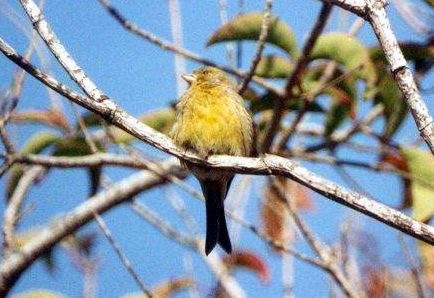Island Canary (Serinus canaria) - Wiki Canary
From Wikipedia, the free encyclopedia
Order: Passeriformes
Family: Fringillidae
[Photo] Island Canary (Serinus canaria). La Palma, the Canary Islands. Author: Martin Cramer (http://home.wxs.nl/~mkramer/).
The Canary (Serinus canaria) sometimes called the Island Canary, Tame Canary or Atlantic Canary, is a small bird in the finch family. It is native to the Azores, the Canary Islands, and Madeira.
It is 12.5 cm long, with a wingspan of 20-23 cm and a weight of 15-20 g. It is yellow-green, with brownish streaking on its back. It is about 10% larger, longer and less contrasted than its relative the Serin, and has more grey and brown in its plumage and relatively shorter wings. The song is a silvery twittering similar to the songs of the Serin and Citril Finch.
Canaries habitat semi-open areas such as orchards and copses, where they nest in shrubs or trees, from sea level up to 1,700 m altitude.
Azores: 30,000-60,000 pairs.
Canary Islands: 80,000-90,000 pairs.
Madeira: 4,000-5,000 pairs.
The bird is named after the Canary Islands, not the other way around, derived from the Latin name canariae insulae ("islands of dogs") used by Arnobius, referring to the large dogs kept by the inhabitants of the islands. The colour canary yellow is in turn named after the yellow Domestic Canary.
Captivity
This species is often kept as a pet; see Domestic Canary for details. Birds have escaped from captivity and have established feral populations on Bermuda, Midway Atoll in Hawaii, and Puerto Rico.
http://en.wikipedia.org/wiki/Island_Canary
| The text in this page is based on the copyrighted Wikipedia article shown in above URL. It is used under the GNU Free Documentation License. You may redistribute it, verbatim or modified, providing that you comply with the terms of the GFDL. |
